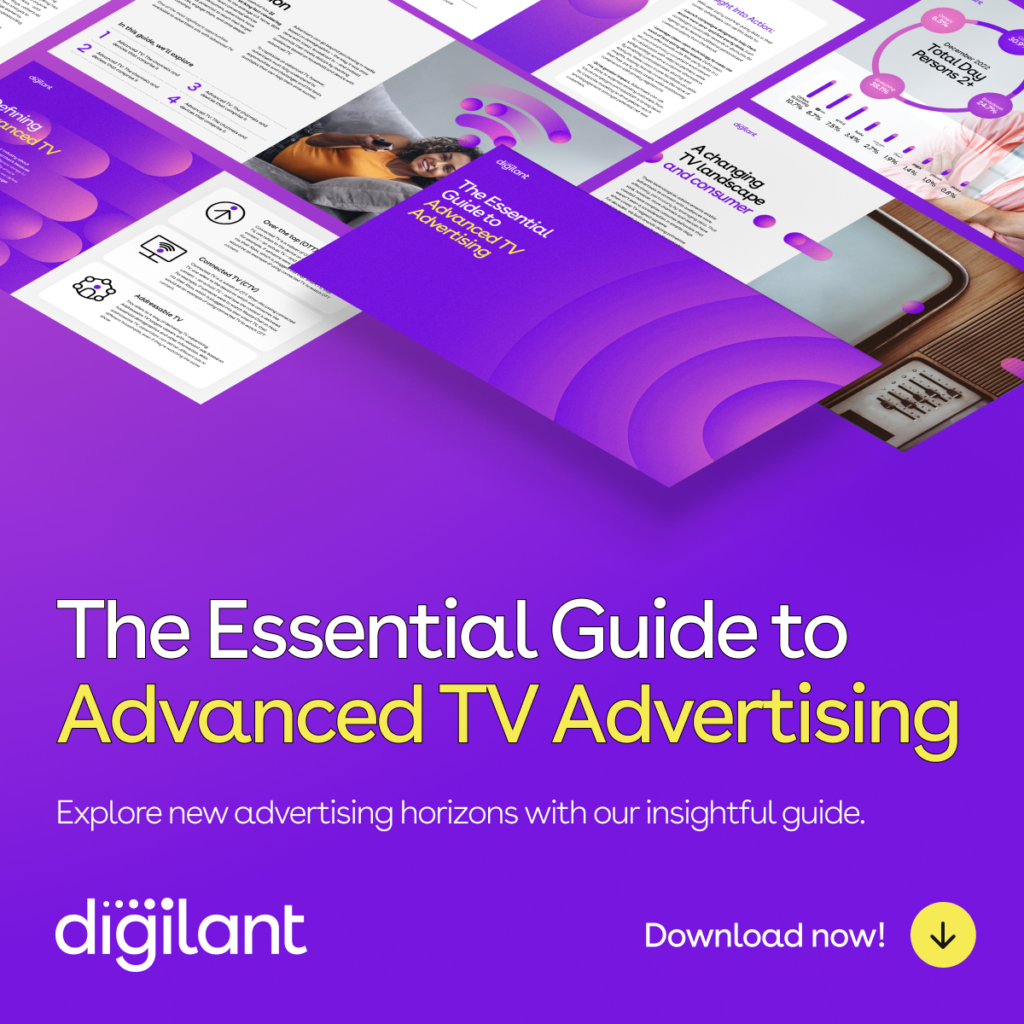Over the past two decades, TV consumption has undergone a massive digital transformation. Netflix was the catalyst, switching from its DVD-by-mail service to streaming in 2007 (remember the outrage – how far we’ve come!). Since then, the number of streaming services has exploded, with over 200 options now available worldwide. The shift to streaming has been significant. In June 2024, streaming accounted for 40% of U.S. TV usage, overtaking cable, which sat at 27.2%, and traditional broadcast TV at 20.5%.
Clearly, there’s a massive consumer shift in how consumers interact with TV content. As such, advertisers need to keep in-step with this trend to ensure their TV ad budgets are reaching a tuned-in audience. However, as more consumers cut the cord and shift from Linear TV* the world of Advanced TV* continues to expand, and keeping up with the many subsets – and acronyms – of this landscape can be daunting.

The Essential Advanced TV Glossary
Below we’ve provided an overview of the most important categories and terms to help you navigate the ever-changing world of television advertising.
OTT (Over-the-Top)
OTT advertising places ads within streaming content delivered over the internet, bypassing traditional cable or satellite TV. This allows advertisers to reach cord-cutters and streamers on platforms like Netflix, Hulu, Amazon Prime Video–the list goes on.
Connected TV (CTV)
CTV refers to ads displayed on internet-connected TV devices, such as smart TVs, gaming consoles, and streaming sticks like Roku. As a subset of OTT, CTV refers to the device on which one consumes the content — an actual TV — and how the content is delivered. In 2023, the average U.S. household with internet connection had 17 connected devices. Between mobile devices, smart TVs, tablets, (the list goes on!), CTV provides advertisers with the combination of expansive reach with the precision targeting of digital media.
Programmatic TV
Programmatic TV automates the buying and selling of TV ad space using software and algorithms, enabling more efficient and data-driven ad placements. Programmatic TV advertising also enables dynamic ad insertion, allowing different ads to be shown to different audience segments watching the same program. This ability to optimize campaigns in real-time ensures higher relevance across audiences and cost efficiency for advertisers.
Addressable TV
Addressable TV allows for targeted ads to be delivered to specific households or individuals based on data points like demographics, interests, or past viewing behavior. For instance, within the same household watching the same show, different ads can be shown to different individuals based on their personal preferences. Addressable TV ensures personalized, relevant messaging to viewers, leading to better engagement and more effective use of ad spend.
Free Ad-Supported Streaming (FAST)
FAST delivers free, linear-like content with ad interruptions, similar to linear TV but without the burden of subscription fees. Services like Samsung TV+ offer users a wide range of programming, from news to entertainment, at no cost. FAST is making a splash (or perhaps causing a tsunami) in TV advertising. By 2027, nearly a third of the U.S. population will be FAST viewers. As a rising star in TV advertising, FAST channels are becoming an essential piece of the media landscape that advertisers shouldn’t overlook.
Automatic Content Recognition (ACR) Data
ACR uses technology which is embedded into the TV to track what viewers are watching across both linear and digital platforms, allowing advertisers to know when their audience is exposed to ads. ACR helps advertisers track viewer behaviors in real-time, enabling precise retargeting and maximizing the impact of campaigns across multiple screens.
Additional Terms to Know
VOD
Video-on-demand is an umbrella term that encompasses all video content requested by on-demand users. You may see subsets such as:
- SVOD (subscription video-on-demand): A subscription-based model offering unlimited access to a content library (e.g., Netflix, Paramount+)
- AVOD (Ad-Supported Video-On-Demand): An ad-supported model offering free content with commercials (e.g., Youtube, Tubi)
- BVOD (Broadcast Video-On-Demand): content provided by traditional TV broadcasters, offering catch-up and on-demand access to their programming via the internet (e.g. Sling TV, Peacock)
- TVOD (Transactional Video-On-Demand): A pay-per-view model where viewers purchase or rent individual titles (e.g. Amazon Prime Video)
- PVOD (Premium Video-On-Demand): A paid model for early access to premium content (e.g., new movie releases)
FEPs
Full-episode player refers to professionally produced TV content available for viewing on any device, including apps and web browsers. FEPs adhere to standard television formats in terms of episode length and structure, allowing advertisers to purchase ads within commercial breaks.
MVPDs
Multichannel Video Programming Distributors delivers traditional TV programming to a consumer’s home through a physical cable or satellite connection.
vMVPDs
Virtual Multichannel Video Programming Distributors like Sling, Hulu, Philo, etc., provides consumers with both live TV and on-demand content through the internet.
TVE
TV Everywhere is content that can be streamed on any device, like HBO Max, allows consumers to watch it across any device whether they have a cable subscription or not.
Reach TV Audiences with Digilant
Ready to harness the full potential of advanced TV advertising for your brand? We’ve got the expertise to help you make the most of it. Let’s chat about how Digilant can drive your campaigns to success!
*Linear TV – the traditional way of watching television, where programs are broadcast on a fixed schedule by networks, and viewers watch at specific times.
*Advanced TV – an umbrella term for non-traditional, not over-the-air broadcast TV – enables advertisers to use data to distribute, target, and measure advertising campaigns.